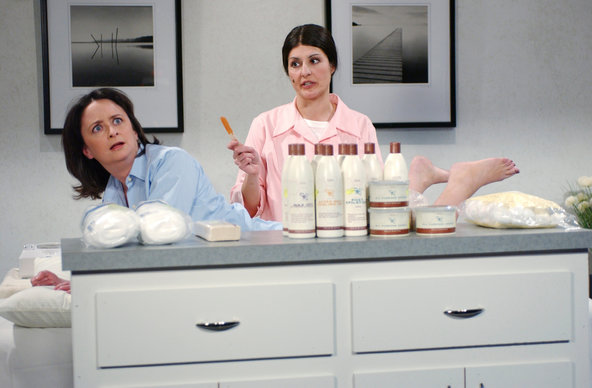
Rachel Dratch, left, as customer and Nia Vardalos as spa technician in a 2002 “Bikini Wax” skit on “Saturday Night Live.” Sixty-two percent of a nationally representative sample of 3,316 women said they opted for complete removal of their pubic hair; 84 percent reported some grooming.Credit Dana Edelson/NBC, via Getty Images
For years, gynecologists have had a bird’s-eye view on a phenomenon that is now so popular as to be almost commonplace: female genitalia, bereft of hair.
Sometimes called “grooming,” the practice of shearing off pubic hair — parodied on “Saturday Night Live,” celebrated as a girl-bonding ritual by various “Real Housewives” — has prompted sexual health experts to ask what motivates women to do it.
A new study published in the journal JAMA Dermatology on Wednesday confirmed just how widespread the practice is. Sixty-two percent of a nationally representative sample of 3,316 women said they opted for complete removal of their pubic hair; 84 percent reported some grooming.
But while previous research showed that women groom to facilitate sexual activity, this survey found the overwhelming majority said they did so for hygiene.
That perception troubled researchers. “Many women think they are dirty and unclean if they haven’t groomed,” said Dr. Tami S. Rowen, an obstetrician-gynecologist and the lead author of the study.
The study found that the practice crossed all ages and races. But the women most inclined to groom are younger, between the ages of 18 and 34. They were more likely to be white, with at least some college education. The researchers did not find associations between grooming and income or marital status.
Anecdotally, gynecologists say they are seeing girls as young as 13 take up grooming, when they have only recently come into puberty. The teenagers, doctors said, are influenced by locker room jeers, social media chatter, and even internet pornography, where female genitalia is often displayed as hairless and almost prepubescent.
“At least once a week I hear from a young woman that she thinks it’s wrong to have pubic hair, that it’s meant to be removed,” said Dr. Jennifer Gunter, who specializes in pelvic pain and vulvovaginal disorders for Kaiser Permanente Northern California. “Grooming has become so common that people think that’s the norm.”
Pubic hair functions as a protective cushion for sensitive skin, and has its own hygienic purpose, trapping bacteria and preventing it from entering the vaginal opening. “Prepubertal girls have a higher incidence of irritation because they don’t have that protection,” Dr. Gunter said.
Dr. Rowen, an assistant professor at the University of California San Francisco School of Medicine, is concerned about grooming’s prevalence both because of a spate of health problems linked to it, and because of what it may suggest about women’s self-image.
She and other doctors have seen grooming-related cases of folliculitis, abscesses, lacerations, allergic reactions to waxing burns, as well as vulvar and vaginal infections. One study has noted that 3 percent of emergency room visits for genitourinary trauma are a result of grooming.
Although some researchers speculate that micro-abrasions and nicks from grooming may facilitate the spread of sexually transmitted infections, no large studies have definitively made that connection. A paper from one clinic did note, however, the rise in the number of so-called Brazilian waxes among patients (men as well as women) and a concurrent decline in pubic hair lice.
But it was this study’s finding that women associate grooming with health and hygiene — many said they groomed before a visit to a health care provider — that disturbs many gynecologists. Women were self-conscious even in private, medical settings.
“I’ve had women say, ‘I’m sorry I didn’t get a chance to clean up down there,’” said Dr. Cheryl B. Iglesia, a professor of obstetrics-gynecology and urology at Georgetown University School of Medicine.
Emphasizing that pubic hair patterns vary widely, according to women’s stages of development, ethnicity and individuality, Dr. Iglesia lamented the popularity of the narrow standard of what she calls “the Barbie doll look.”
The results of this study are part of a larger project looking at grooming by men as well as women, exploring demographics, motivation, perceptions, sexual behavior and health habits.
Women were more likely to groom if their partner expressed a preference for it, the study found. But while earlier smaller studies had shown a link between grooming and sexual activity, particularly oral sex, this study found that while some women groomed for that purpose, it was not the primary reason: For example, 22 percent of the women reported grooming around the area of the anus, but only 10 percent had partaken in anally related sexual activity in the prior year.
Instead, the researchers said, providers of health care and aesthetic treatments should become attuned to the diversity of reasons that women groom. The women also said they did so for vacation and because they see their own genitalia as more attractive when groomed.
“If it is something you do for you and makes you feel better, awesome,” Dr. Gunter said.
But noting that 59 percent of the survey’s responders said they groomed for hygienic reasons, she added, “But don’t tell yourself it’s healthy or better from a medical standpoint.”






